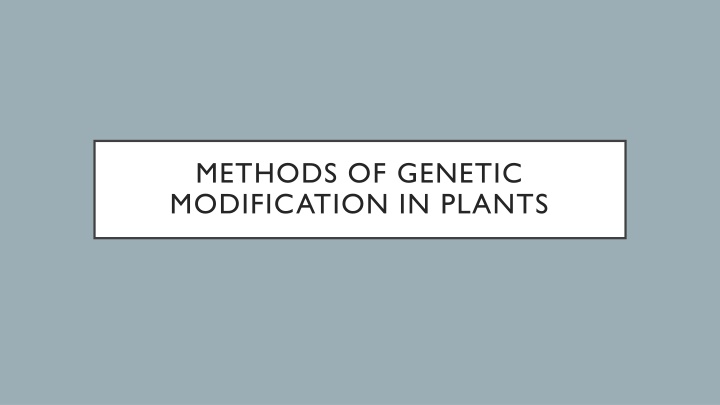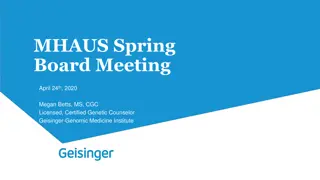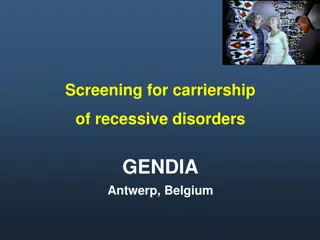Different Methods of Genetic Modification in Plants
Genetic modification in plants can occur through natural selection, selective breeding, and induced mutations. Natural selection involves breeding compatible species to create offspring with desired traits, while selective breeding is a multi-generational process to breed organisms with specific characteristics. Induced mutations involve exposing seeds to various factors to induce genetic changes. Each method has its advantages and considerations in plant modification.
Download Presentation

Please find below an Image/Link to download the presentation.
The content on the website is provided AS IS for your information and personal use only. It may not be sold, licensed, or shared on other websites without obtaining consent from the author.If you encounter any issues during the download, it is possible that the publisher has removed the file from their server.
You are allowed to download the files provided on this website for personal or commercial use, subject to the condition that they are used lawfully. All files are the property of their respective owners.
The content on the website is provided AS IS for your information and personal use only. It may not be sold, licensed, or shared on other websites without obtaining consent from the author.
E N D
Presentation Transcript
METHODS OF GENETIC MODIFICATION IN PLANTS
NATURAL SELECTION Definition: Breeding two compatible species to create an offspring, which may or may not have the desired traits. FACTS: Breeding two compatible species to create an offspring, which may or may not have the desired traits. Occurs naturally without any intentional human intervention. Traditional laws of heredity and inheritance determine which traits will be expressed in offspring. If an organism has a trait that is of benefit, this it will have a greater chance of reproducing and passing on that gene (e.g. survival of the fittest ).
NATURAL SELECTION ADVANTAGES: CONSIDERATIONS: Occurs naturally without any intentional human intervention. Not able to target specific traits to be carried forward to the next generation. Low cost - does not require special equipment or knowledge Multiple generations required. Limited to the genes already found in the genome of the species. Laws of inheritance may limit the inheritance of a trait, especially if it is recessive. Future generations may not retain the trait if it isn't genetically based.
SELECTIVE BREEDING Definition: The multi-generational process of breeding same-species organisms with desirable characteristics to produce an offspring that exhibits the desirable trait. FACTS: The multi-generational process of breeding same-species organisms with desirable characteristics to produce offspring that exhibit the desirable trait. Process used to domesticate plants by early farmers 10,000 years ago. Farmers select for specific traits they would like to be passed down to future generations. Reduces genetic diversity within the species. . Photo Credit: Expert Guidance
SELECTIVE BREEDING ADVANTAGES: CONSIDERATIONS: Farmer targets plants with desired traits for breeding (e.g. taste, color, texture, yield). Modification is limited to the genes already found in the genome of the species. Long practiced and familiar; there are very few public concerns associated with the technology. Laws of inheritance may limit the inheritance of a trait, especially if it is recessive. There is no guarantee that the desired traits will pass on to the offspring. Potential to reduce or eliminate genetic diseases. There is a limited ability to select for individual traits. While selecting for one specific trait, other traits may also be adopted that could be negative, positive, or of no significant consequence. Low cost - does not require special equipment or knowledge. Can establish new plant and animal varieties (e.g. domesticated dog varieties). Inbreeding for a specific trait may reduce or redistribute the genetic diversity in the gene pool. Once established, future generations maintain the improved trait in their genome. Need to screen large populations of plants for a given trait to be breeded. Affects the natural evolution of the species. May require multiple generations for the trait to be expressed in a majority of offspring.
INDUCED MUTATIONS Definition: A process of exposing seeds to physical, chemicals or biological mutagens (e.g. UV light, X rays) to promote genetic mutation in hopes that the mutation will produce a desirable trait. FACTS: A process of exposing seeds to physical, chemicals or biological mutagens (e.g. UV light, X rays) to promote genetic mutation of the DNA sequence. There is little to no control over the effect of the mutation on traits. Can happen naturally due to solar radiation or natural errors during DNA replication or be artificially induced. Increases genetic diversity within the species and can affect the physical expression of traits. After exposing a grapefruit tree to radiation, a random genetic mutation produced fruit with a darker color. Photo Credit: www.tradingatoms.com
INDUCED MUTATIONS ADVANTAGES: CONSIDERATIONS: Creates random variation in the genes by promoting gene mutations. Traits produced are random, not selected in any way. There is little to no control over the traits that are produced. Need to screen large populations of plants for a given trait to find a desired mutation. Do not know how many mutations have actually been made in the genome.
GENOME DUPLICATIONS Definition: Breeding two plants of the same species to create an offspring with multiple sets of chromosomes, affecting its traits. FACTS: Breeding two plants of the same species to create an offspring with multiple sets of chromosomes. Results in plants with multiple sets of DNA and multiple copies of a gene affecting its expression. Occurs in approximately 1/3 of flowering plants naturally. Tends to produce larger cells, resulting in larger plant parts and generally enhancing vigor. Often results in sterile offspring (e.g. seedless plants). Can happen naturally as a mutation during cell division. Photo Credit: BioNinja
GENOME DUPLICATIONS ADVANTAGES: CONSIDERATIONS: Plants have the general advantage of heterosis and gene redundancy. If plants are sterile (do not produce viable seeds), extra time and money is required by farmer to produce the plants. Plants can become sterile. In the case of a seedless watermelon, this is a desired trait. Increases species genetic diversity, providing additional DNA and genes for evolution. Polyploid plants tend to be larger.
GENE EDITING Definition: The process of using enzymes to cut, replace, or insert genes within a plant s DNA to affect its traits. FACTS: The process of using enzymes to cut, replace, or insert genes at a specific location within a plant s DNA. Targeted to affect the expression of a specific trait within that species. Results in immediate and exact change to the DNA sequence. Requires expertise and specialized equipment technology is rapidly advancing Utilizes DNA from another organism, either of the same species (cisgenic) or another species (transgenic). Photo Credit: Vox Media
GENE EDITING ADVANTAGES: CONSIDERATIONS: Allows specific and exact changes to a genome by making additions, deletions, or specific changes to a DNA sequence, which affects the expressed trait. Requires skill, knowledge, and special equipment to be effective. Some consumers are concerned about the concept and the lack of understanding about the various long-term effects and unintended consequences. Faster than conventional breathing Can use cisgenes (from the same or an infertile species) or transgenes from another species). May contribute to increased populations of pesticide- and herbicide-resistant pests and weeds. Allows scientists to specifically target the gene associated with the trait they are trying to produce in the plant (e.g. insect resistance, drought tolerance, yield, nutritional value). Need to screen large populations of organisms to identify the gene associated with a given trait. May be an increased risk of allergies or food intolerance. Trait is immediately inserted and able to be passed on to offspring. Monoculture farming reduces biodiversity. May reduce environmental impacts associated with farming (increased yield requiring less land to be farmed, less quantity of herbicides/pesticides required).























